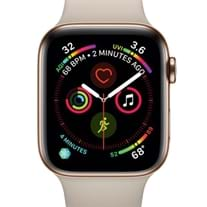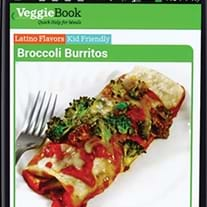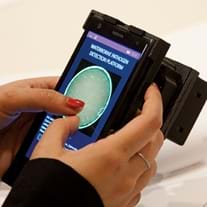The Cutting Edge: There’s An App For That
Researchers are making greater use of the increasing computational power found in smartphones — meaning apps may soon be able to help improve human health outcomes.

Photo credit: Apple Inc.
By Charles Cooper, Academy Contributor
Apple CEO Tim Cook has major ambitions to “democratize” the health sector. In a recent interview with CNBC, Cook said that “health will be the company’s greatest contribution to mankind.” He’s also enlisted an important ally to help Apple make that happen.
Atrial fibrillation, which affects 33 million people worldwide, can lead to blood clots, stroke and heart failure. But later this year, Johnson & Johnson (J&J), which developed a heart health application, will carry out a study of volunteer patients 65 and older wearing an Apple Watch to understand whether smartphone technology can help enhance the accuracy and speed of clinicians’ efforts for earlier detection, diagnoses and treatment of the malady.
“Five years from now — and certainly within a decade — wearable devices will be an integral part of healthcare diagnosis and delivery,” said Paul Burton, MD, PhD, FACC, Vice President, Medical Affairs, Janssen Scientific Affairs, LLC, noting that the app will work in conjunction with the Apple Watch Series 4’s irregular rhythm notifications and ECG feature.
The diodes on the back of an Apple Watch Series 4 essentially look for a pulse to check blood flow and applies an algorithm to determine whether the pattern pulses are irregular. It has the capability to take a high-fidelity ECG reading which is then sent to a physician. That kind of real-time data is crucial when you consider that around 20 percent of individuals who experience a stroke are not aware of their underlying AFib condition.
The widening availability of digital tools, paired with advances in technologies like artificial intelligence and machine learning, is raising hopes that history will repeat itself. In the last decade, business applications helped organizations become more efficient and to better engage with their customers. Now researchers are making greater use of the increasing computational power found in smartphones and it’s no longer a stretch to imagine a future in which there’s an app for nearly every step in the research process.
Burton expressed excitement at the potential of apps to make changes in behavior and improve health outcomes in ways that were unimaginable less than a decade ago. “I think this is an amazingly exciting point bound only by our imagination. I think the possibilities are endless,” Burton said. “AFib is treatable but you need definitive, compelling data to really make a difference in healthcare.” At the same time, Burton cautions that “apps don’t work if people download them but can’t be bothered to use them.” The point being that all the technology in the world won’t help, if the people who need it most don’t incorporate the tools into their lifestyles.
Promises and Reality Checks
That challenge was faced head-on by University of Southern California research scientists Susan Evans and Peter Clarke, as they tested out a mobile app they developed to help low-income people who use food pantries to obtain fresh vegetables, which, while often plentiful in supply, may be limited in variety.
Though the use of health-related mobile apps are now common, the promise and the performance often don’t match up. Clarke noted that fewer than one percent of the estimated 330,000 apps available on the Apple and Android download stores have been subjected to rigorous testing for effectiveness.
“Getting people to incorporate devices and apps into their lives is a whole separate science,” he said.
In developing their app, Evans and Clarke made sure the design incorporated user input early in the process, just as if they were creating a consumer app. For example, even though food banks collect fresh food and vegetables, many low income people aren’t incorporating those offerings into their diet because they may not know how to cook and/or preserve the food that’s available.
Evans and Clarke, who started the project with certain assumptions about what was needed, were forced to refine their ideas about how to change dietary habits and that came only after extensive field research and speaking with the people they hoped would ultimately use the app.
“We had to customize the app in order to meet clients’ needs and not impose this on them from the top,” said Evans. “It took years of tinkering. In terms of functionality and navigation, we designed it over and over again to try and get it right.”
Technology Is Only as Good as the User

As scientists and researchers struggle with the alchemy of user engagement, they have the advantage of being able to lean on the experience of software developers working in the consumer and business markets. Unfortunately, there’s no one size-fits-all answer explaining how to get a target audience not just to download the applications, but to also use them consistently.
University of Michigan computer scientist Kentaro Toyama struggled to understand the nuances surrounding successful user engagement when he worked as assistant managing director of Microsoft Research in India. Toyama’s team built several different digital apps in areas like healthcare and social services that performed well in the labs. But few survived the test of time after they were released to the public.
“When we did these research projects in relatively constrained contexts, we could show how technology has a positive impact,” he said. “However, when we scaled those projects, we found that it did not have the same impact. Technology can be extremely good at delivering what people want,” he said. “It’s not so good when it comes to encouraging [people] to become better versions of themselves.”
Marissa Burgermaster would probably agree. As an elementary and middle school teacher she became interested in how food and nutrition influenced the lives of the students she taught. Ultimately she decided to pursue a doctorate in behavioral nutrition.
During the course of her research, she also discovered a seeming contradiction: As a whole, nutrition education interventions didn’t produce tremendous results, but anecdotally they did appear to work for at least some students.
“What kept coming across from the data was … that different groups of kids … responded quite differently to the intervention,” she said. “That explained why an average intervention didn’t get great results — even though for some kids, it was exactly what they needed.”
Burgermaster said it underscored the importance of accumulating as much data as possible before the fact. She went on to do her post-doctoral research in biomedical informatics and nowadays teaches in the Department of Nutritional Sciences at the University of Texas, Austin. Burgermaster kept the lesson in mind when she set out to develop an app that provides nutrition information to underserved communities.
“The reason why I was drawn to intervening via technology was not just to use data, but also it’s about meeting people where they are and get them to where they need to be. And let’s be honest: people are stuck in their phones,” she said.
The app, which is rolling out this spring in Austin, offers users personalized recommendations with tailored nutritional recommendations and interventions to help them reach their goals. Like J&J’s test project with Apple, it’s another indication of the potential for health practitioners to use smartphone and wearable technology to generate data about their patients to help with diagnoses.
A Mobile Lab in Every Home

When Aydogan Ozcan talks about the potential of smartphone apps to effect transformative changes, don’t expect to hear him riff about cool new ways to arrange virtual candies on a screen or share adorable cat videos. He has a far bigger goal in mind.
Over the years, Ozcan’s lab has focused on developing field-portable medical diagnostics and sensors for resource-poor areas, coming up with relatively inexpensive ways to equip smartphones with advanced imaging and sensory capabilities that once were only found in expensive high-end medical instruments.
In the last decade, he has come up with ways to exploit the functionality available in contemporary smartphone hardware and software to further bio- and nano-photonics research. For example, one technique allowed a smartphone to produce images of thousands of cells in samples that were barely eight micrometers wide — and at the cost of less than $50 in off-the-shelf parts.
More recently, Ozcan demonstrated how the application of deep learning techniques can generate smartphone images that approach the resolution and color details found in laboratory-grade microscopes using 3-D printed attachments that cost less than $100 apiece.
“Instrumentation is very expensive. The cost of advanced microscopes, for example, can run to hundreds of thousands of dollars,” said Ozcan, a professor of electrical and computer engineering and bioengineering at the UCLA Samueli School of Engineering, and a three-time Blavatnik National Awards for Young Scientists finalist.
Smartphones are relatively inexpensive with more than 3 billion people using them around the world, encouraging Ozcan to envision a future where resource-poor nations will have expanded access to advanced measurement tools, that provide data for local residents to better treat medical conditions. Think of the average smartphone one day functioning as a mobile medical lab.
Ozcan also believes that people in their homes will soon be using a growing assortment of advanced mobile technologies and apps for preventive care, particularly when it comes to monitoring an aging patient or someone with a chronic condition.
“In the U.S., five percent of patients cause 50 percent of health expenditures per year. We can reduce that cost with better preventive care but for that, the home needs better technology. We should be able to provide that with mobile cost-effective systems so you can do some of the measurements that would normally require sending people to the hospital to take a sample, wait for the results and then go to the pharmacy with a prescription.”
We may not be there yet, but the world is fast approaching that tipping point where mobile apps lead to a veritable explosion of powerful, cost-effective alternatives to some of the most advanced biomedical imaging and measurement tools now in the market.
